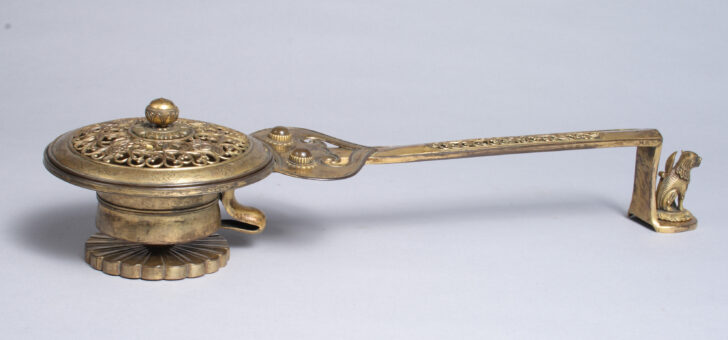Egôro (ritual censer)
Japanese

Description
Ego ̄ro (ritual censer)
Japan
Momoyama (1583–1615) to Edo (1615–1867) periods
16th to 17th century
Gilt bronze with semiprecious stones
Museum purchase made possible by the Margaret
Watson Parker Art Collection Fund, 2007/2.6
In Japanese Buddhist rituals, the ego ̄ro, or long-handled censer,
signifies the authority of the celebrant. During a ritual it is
placed in front of the icon of the divinity, and the fragrant smoke
of the incense is believed to clear away evil spirits. Originally
used in Buddhist rituals, these censers were adopted by
practitioners of Japan’s indigenous Shinto ̄ spiritual tradition and
used for similar ritual purposes. This ego ̄ro is decorated with
many Buddhist motifs: at the end of the L-shaped handle, a lion
is seated on a lotus pedestal; auspicious clouds are etched into
the rim of the brazier; the grille depicts the swirling stocks and
flowers of lotuses; and at the center of the lid is a wish-fulfilling
jewel, symbolic of blessings.
Subject Matter:
In Japanese Buddhist rituals, a long-handled censer, egôro, signifies the celebrant’s authority. In processions the chief priest leads the other monks, holding an egôro. During the ritual, he frequently picks up the egoro and places it in front of the image of deity to offer incense to the deity. Fumigation is believed to clear evil sprit.
This beautiful, gilded egôro was used in rituals of Japan’s indigenous Shintô religion. Since the introduction of Buddhism to Japan in 7th century, Shinto adopted many aspects of Buddhist practices and representations. The UMMA egôro has familiar Buddhist motifs, such as a lion on the knob handgrip, lotus flowers on the brazier lid and the handle, and a stylized jewel shape on the mounting between the brazier and the handle.
Physical Description:
It is a bronze incense burner with a long handle. The circular bowl is a brazier, in which incense is burnt in Shinto rituals. The brazier has a fluted mouth and double-lines on the outside body. A circular foot, in a chrysanthemum shape, is attached to the brazier. There is a support that connects between the brazier and the foot. The brazier’s lid has an intricate openwork design of lotus flower scrolls with a knob in the shape of a lotus bud. The rim has an incised, stylized design of clouds. The mounting between the brazier and the handle is in the shape of Buddhist jewel with two semi-precious stones. The handle has carved lotus flower scrolls, and the end of which is bent at a right angle and joined to a round pedestal. Rising from the pedestal is a small statue of a lion on a lotus-shape pedestal, which serves as a knob handgrip when the incense burner is held.
Usage Rights:
If you are interested in using an image for a publication, please visit https://umma.umich.edu/request-image/ for more information and to fill out the online Image Rights and Reproductions Request Form.